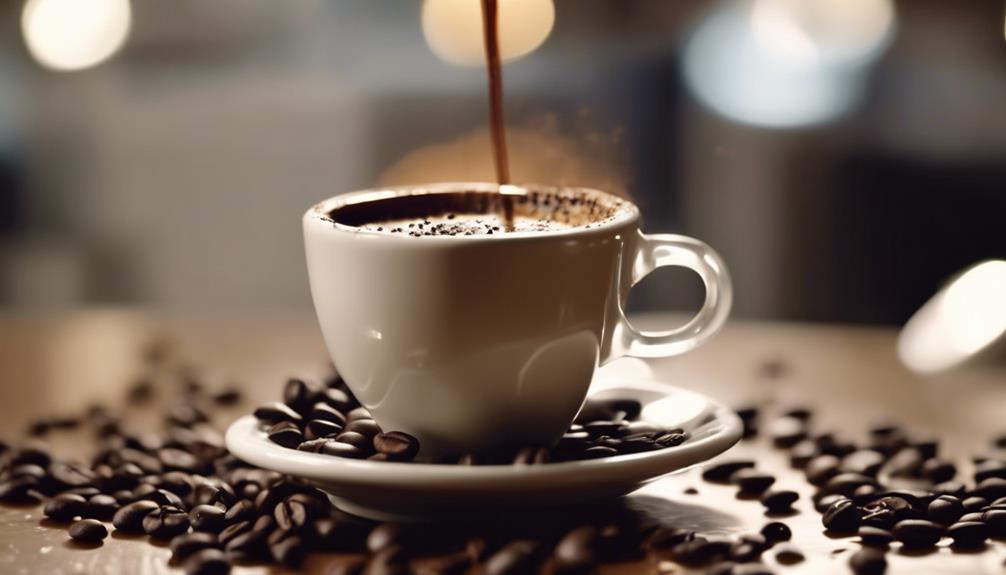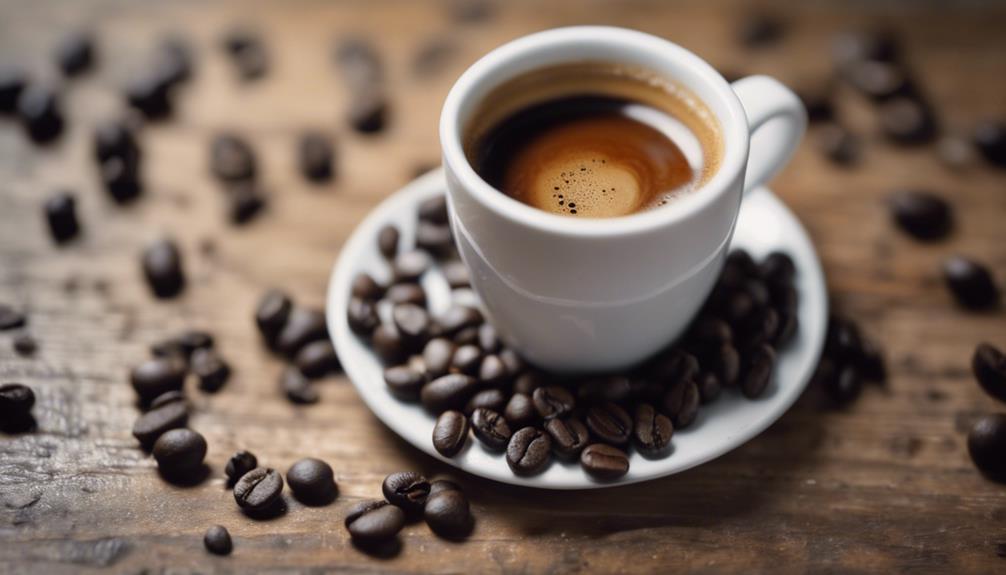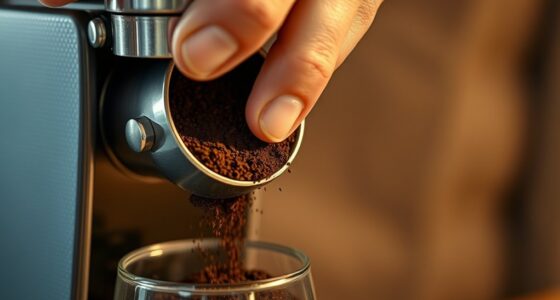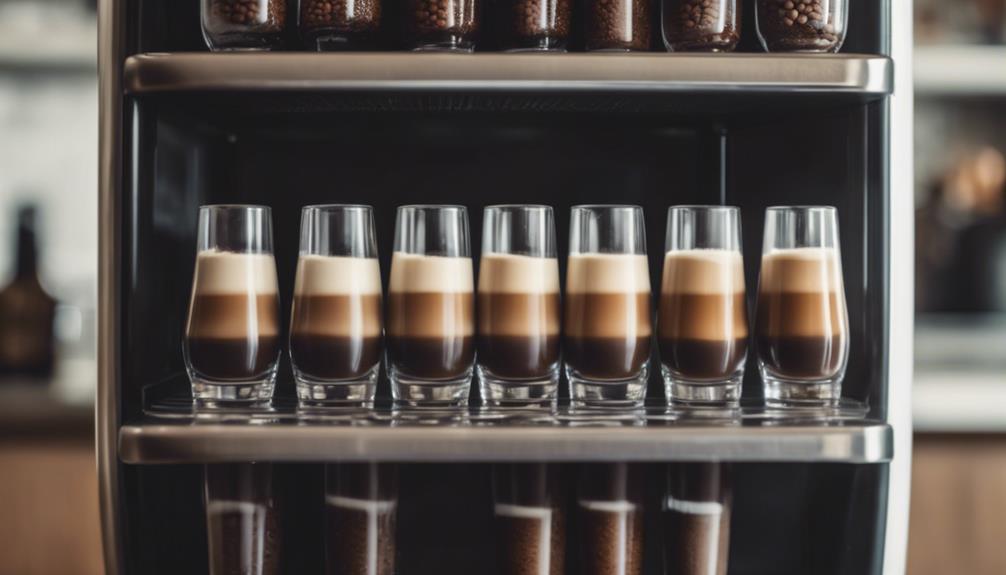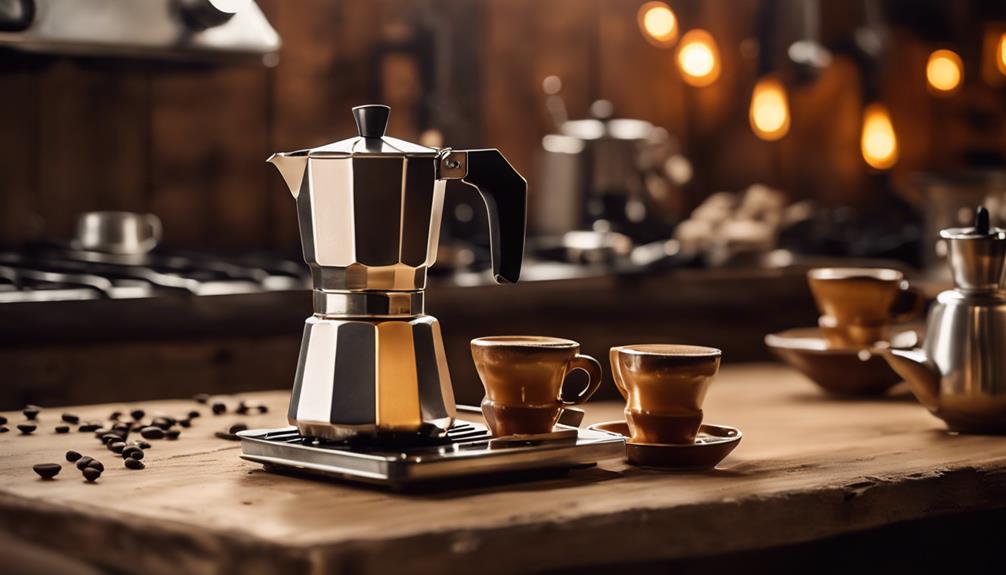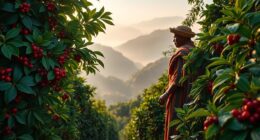You are likely consuming more caffeine than you realize from your daily espresso routine. A single shot of espresso contains about 63mg of caffeine, while a double shot has around 126mg. However, when you order a Starbucks espresso, you are actually getting around 75mg of caffeine. Interestingly, brewed coffee typically has more caffeine overall due to larger serving sizes. It is important to note that factors such as coffee bean type, roast, and brewing method can all impact the caffeine content. As you delve into the world of espresso, you will uncover that there is more to it than just a quick caffeine boost – what will you discover next?
Key Takeaways
- A single shot of espresso typically contains around 63mg of caffeine, while a double shot contains approximately 126mg.
- Espresso has a higher caffeine concentration per ounce compared to brewed coffee, but brewed coffee often has a higher total caffeine content due to larger serving sizes.
- Factors such as coffee bean type, roast type, brewing method, and grinding and brewing amount can influence the caffeine levels in espresso.
- The perception of caffeine effects from espresso can vary depending on consumption speed, individual tolerance, and psychological factors.
Caffeine Content Comparison
When you compare the caffeine content of espresso to brewed coffee, you'll find that a single shot of espresso packs a significant punch, but its overall caffeine content still lags behind a standard cup of brewed coffee.
A single shot of espresso typically contains around 63 mg of caffeine, which may seem like a lot, but it's actually less than what you'd find in a standard 8-ounce cup of brewed coffee, which can have anywhere from 96-128 mg of caffeine.
Even a double shot of espresso, which contains around 126 mg of caffeine, is comparable to a standard cup of brewed coffee.
To put this in perspective, a Starbucks espresso shot contains around 75 mg of caffeine, which is slightly higher than the average.
It's worth noting that caffeine levels in coffee can vary greatly depending on the brewing method, bean type, and roast level.
However, in general, brewed coffee tends to have a higher amount of caffeine than a single espresso shot.
Factors Influencing Caffeine Levels
You might be wondering what makes the caffeine content of your espresso or brewed coffee vary so greatly from one cup to the next. The answer lies in several factors that influence caffeine levels.
First, the brand of coffee you choose can greatly impact the amount of caffeine in your cup, due to variations in formulations. The type of coffee beans used also plays a vital role, with Robusta beans containing approximately twice the caffeine of Arabica beans.
The roast type of your coffee beans is another key factor, with light roasts generally retaining slightly more caffeine than dark roasts. The amount of coffee you use when brewing is also important, as higher doses lead to increased caffeine extraction.
Perception of Caffeine Effects

One shot of espresso can hit you harder than a cup of coffee, and it's not just because of the caffeine content. The way you consume espresso plays a significant role in how you perceive its caffeine effects. Since espresso has a smaller serving size, you tend to drink it quickly, which can lead to a more intense caffeine jolt compared to sipping brewed coffee slowly.
Your individual tolerance to caffeine also affects how you experience its effects. If you're sensitive to caffeine, even a small amount can have a significant impact.
The concentrated nature of espresso, with approximately 63 mg of caffeine per ounce, contributes to its stronger perceived effects. In contrast, brewed coffee averages around 12-16 mg of caffeine per ounce.
Additionally, psychological factors, such as expecting an energy boost from espresso, can influence how you perceive its caffeine effects. The rapid consumption of espresso can enhance the immediate effects of caffeine on your central nervous system, resulting in a quicker boost in alertness and energy levels.
Health Recommendations and Considerations
The FDA's guidelines suggest that healthy adults limit their daily caffeine intake to 400 mg, a threshold that's easily manageable with espresso, thanks to its controlled serving size.
With a single shot of espresso containing around 63 mg of caffeine, you can easily keep track of your intake. If you're looking for a customized caffeine level, espresso drinks like lattes and cappuccinos typically contain one or two shots, allowing you to adjust to your taste.
Plus, enjoying espresso with milk can enhance the experience while potentially reducing the overall caffeine concentration per serving.
However, if you're sensitive to caffeine, you should be mindful of your total daily intake from all sources, including tea, chocolate, and certain medications. Don't exceed the recommended 400 mg to avoid any negative effects.
Coffee and Espresso Equipment Essentials
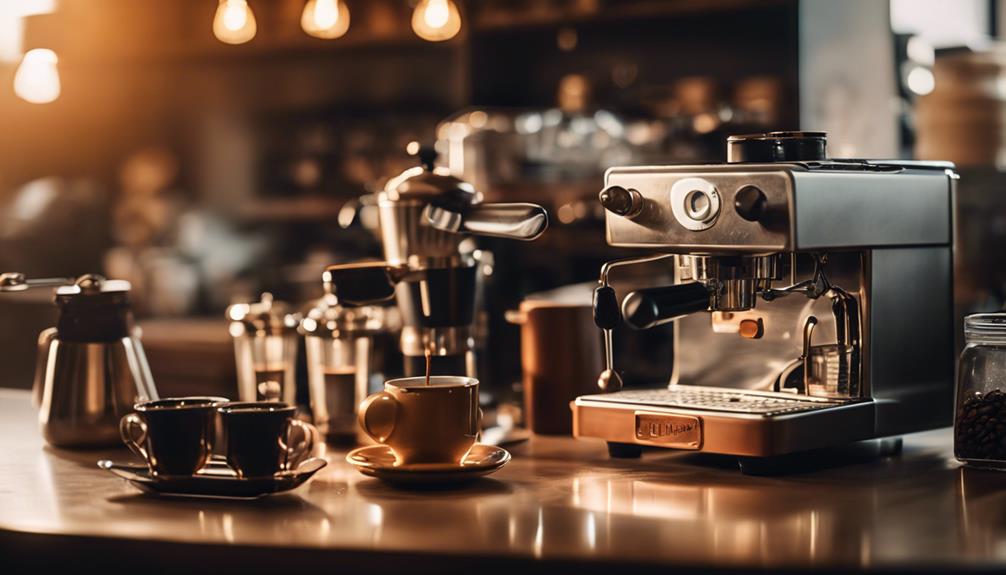
Investing in the right coffee and espresso equipment can elevate your brewing experience, as quality machines and grinders guarantee ideal flavor and caffeine extraction. When choosing an espresso machine, consider the type of brew method you prefer. Traditional machines require around 9 bars of pressure for optimal extraction, while stovetop Moka pots use steam pressure to brew a concentrated coffee. Consumer Reports recommends machines with consistent temperature control and pressure for the perfect shot of espresso.
Regular maintenance and cleaning of your machine are essential to guarantee optimal performance and prevent the buildup of coffee oils that can affect flavor and caffeine output.
With the right equipment, you can enjoy a wide range of coffee drinks, from lattes to cappuccinos, with precise caffeine counts. Quality grinders will guarantee the perfect grind size for your espresso, and espresso machines will extract the optimal amount of caffeine from your ground coffee.
Understanding Espresso Basics and Preparation
Mastering the art of espresso preparation begins with a solid grasp of the brewing process, which involves forcing pressurized hot water through finely-ground coffee beans to extract the perfect shot.
When you brew espresso, you're aiming for a concentrated coffee with a higher caffeine concentration than brewed coffee. A standard shot of espresso is approximately 1 ounce and contains around 63 mg of caffeine.
To achieve this, you'll need to use the ideal water temperature, between 190°F to 205°F, and an extraction time of 25 to 30 seconds. This will result in ideal flavor and crema formation, which is the golden foam on top of a well-pulled espresso shot.
The crema signifies a successful extraction process and contributes to the overall flavor profile.
As you experiment with different brewing methods, such as traditional machines, stovetop Moka pots, and portable espresso makers, you'll notice how they affect the final taste and caffeine content of your espresso.
Caffeine in Espresso Drinks and Beverages
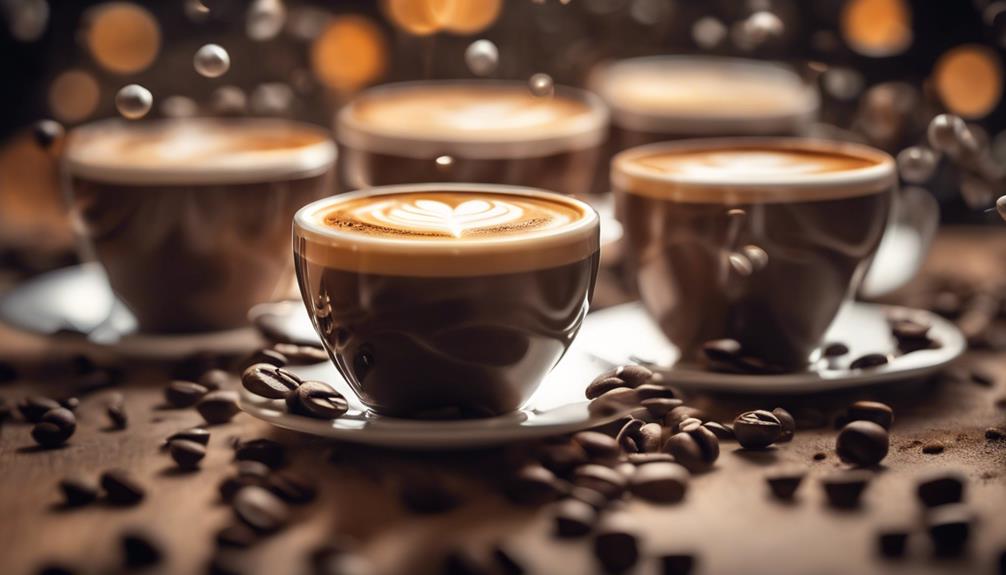
As you move beyond the basics of espresso preparation, you'll want to understand the caffeine content in various espresso drinks and beverages, which can vary considerably depending on the type of drink and preparation method.
When you order at Starbucks, you can expect a single shot of espresso to contain around 75 mg of caffeine, while a double shot will give you about 150 mg.
Espresso-based drinks like cappuccinos and lattes typically contain 75 mg of caffeine for short/tall sizes and 150 mg for grande/venti sizes, depending on the number of espresso shots used. If you prefer a mocha, you'll get 90 mg of caffeine for short/tall sizes, which can increase to 180 mg for venti sizes due to the added chocolate.
Americanos, on the other hand, can range from 75 mg of caffeine for short sizes to 300 mg for venti sizes, depending on the number of espresso shots included.
It's clear that the concentration of caffeine in espresso drinks varies greatly based on the preparation method, serving size, and number of espresso shots used.
Debunking Common Caffeine Misconceptions
As you explore the world of espresso, you've likely heard some misconceptions about its caffeine content. There is a common belief that espresso has significantly more caffeine than regular coffee, but this is actually a misconception. In reality, the caffeine content in espresso is lower than in a standard cup of coffee. This is because espresso is brewed with a smaller amount of water, resulting in a more concentrated beverage. So while the flavor of espresso may be bold and intense, its caffeine content is actually relatively low compared to other coffee drinks.
You might think that espresso has more caffeine than brewed coffee, but that's not entirely true – it's all about serving sizes.
Let's clear up these caffeine comparison misconceptions and get the facts straight about espresso versus brewed coffee.
Caffeine Comparison Misconceptions
You've likely heard that espresso packs a much stronger caffeine punch than brewed coffee, but surprisingly, this common assumption is often misleading.
While espresso has a higher concentration of caffeine per ounce, the total caffeine content in brewed coffee is often higher due to its larger serving size. For instance, a single 1-ounce shot of espresso contains about 63 mg of caffeine, whereas an average 8-ounce cup of brewed coffee contains 96-128 mg.
Even a double shot of espresso (2 ounces) can't compete with the caffeine in a standard cup of brewed coffee, containing about 126 mg. The misconception arises from ignoring serving sizes; many espresso drinks contain varying amounts of caffeine depending on the number of shots used.
Espresso Vs. Brewed Coffee
Compare your daily espresso shot to a freshly brewed cup of coffee, and you might be surprised to find that the latter often packs a more substantial caffeine punch. While espresso is often perceived as the more intense type of coffee, the amount of caffeine in a typical cup of brewed coffee far surpasses that of a single shot of espresso.
Here are some key points to reflect on:
- Caffeine per ounce: Espresso contains around 63 mg of caffeine per ounce, while brewed coffee averages 10-16 mg per ounce.
- Shot vs. cup: A single shot of espresso (1 ounce) has approximately 63 mg of caffeine, whereas an 8-ounce cup of brewed coffee typically contains between 96 and 128 mg of caffeine.
- Double shot vs. larger cup: Even a double shot of espresso (2 ounces) can't match the caffeine content of a 12-ounce cup of brewed coffee, which can exceed 120 mg.
- Consumption speed: You might feel the effects of espresso more quickly due to its rapid consumption, but this doesn't mean it has a higher caffeine level than brewed coffee.
Frequently Asked Questions
Which Espresso Has the Most Caffeine?
You're wondering which espresso has the most caffeine? Well, a double shot of espresso, also known as a doppio, typically packs the most caffeine, with around 150 mg per serving, making it the top choice for caffeine lovers.
Is 2 Shots of Espresso a Lot of Caffeine?
'You're about to release a caffeine tornado on your system! Two shots of espresso are a lot of caffeine, equivalent to an 8-ounce cup of brewed coffee, so be prepared for a serious energy boost and potential jitters!'
Is 20 Shots of Espresso Too Much?
You're wondering if 20 shots of espresso are too much? Absolutely, it's way excessive! Consuming that amount would put you way over the safe limit, leading to severe side effects, potential toxicity, and serious health risks.
How Much Caffeine Is in Espresso Compared to Regular Coffee?
Coincidentally, you're wondering how much caffeine is in espresso compared to regular coffee, and it turns out a single shot of espresso has about 63mg, while an 8-ounce cup of coffee has around 96-128mg, surprisingly more due to its larger serving size.
Conclusion
Now that you've got the lowdown on espresso caffeine content, you can sip with confidence!
Remember, it's not just about the buzz, but about savoring the experience.
With your newfound knowledge, you'll be the ultimate espresso connoisseur, steering through factors that influence caffeine levels and debunking common misconceptions like a pro.
So go ahead, indulge in that perfect shot – your taste buds (and your energy levels) will thank you!
